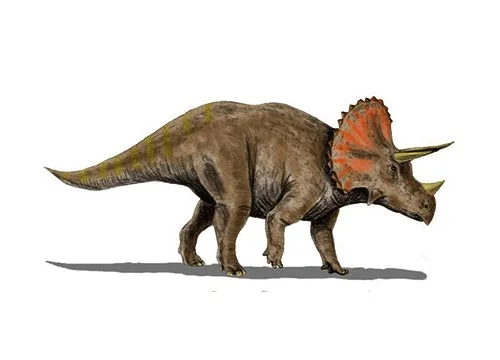Triceratops (Three horned face)

Tri-seh-rah-tops
Othniel Charles Marsh - 1889
Herbivore
Estimated 9 meters long
Ceratopsian
T. horridus (type), T. prorsus
USA, Colorado, Montana, South Dakota, Wyoming. Canada, Alberta, Saskatchewan
Late Cretaceous, 68-66 million years ago
Triceratops Facts
Triceratops, meaning “three-horned face,” is a genus of herbivorous ceratopsian dinosaur that lived during the Late Cretaceous period, around 68-66 million years ago. It is one of the most famous and recognizable dinosaurs, known for its distinctive frill and three horns on its head.
Triceratops was a large animal, measuring up to 30 feet (9 meters) in length and weighing around 6-12 tons. It had a massive, bony frill on the back of its head that likely served as a display structure, and three horns on its face – one on its nose and two above its eyes. These horns may have been used for defense against predators, as well as for intraspecific combat during mating and territorial disputes.
Triceratops had a beak-like mouth and rows of teeth that it used to grind up tough plant material. It likely fed on low-growing vegetation such as ferns, cycads, and conifers. Triceratops likely lived in herds and may have had complex social behaviors.
Triceratops is known from many well-preserved fossil specimens, including complete skulls and skeletons. It is one of the most studied dinosaurs, and its fossils have provided valuable insights into the anatomy, behavior, and evolution of ceratopsian dinosaurs.
In popular culture, Triceratops is often depicted as a fierce and powerful dinosaur, capable of defending itself against even the largest predators. It is a popular subject in movies, books, and other media, and has become a beloved symbol of the dinosaur age.
In conclusion, Triceratops was a large, herbivorous ceratopsian dinosaur that lived during the Late Cretaceous period. It is known for its distinctive frill and three horns on its head, which may have been used for defense and intraspecific combat. Triceratops likely fed on low-growing vegetation and may have lived in herds with complex social behaviors. Its fossils have provided valuable insights into the anatomy, behavior, and evolution of ceratopsian dinosaurs, and it remains one of the most famous and recognizable dinosaurs in popular culture.



